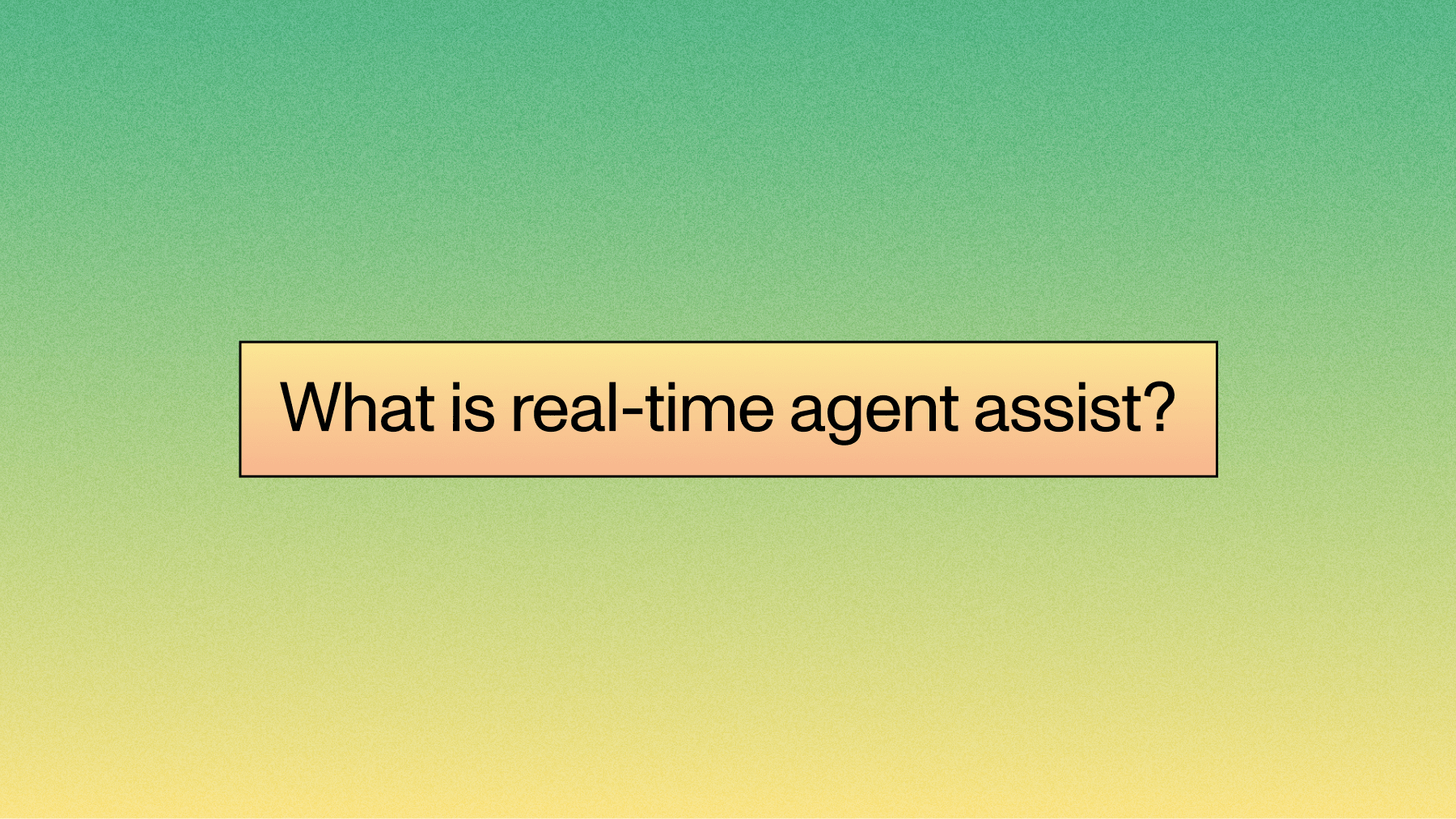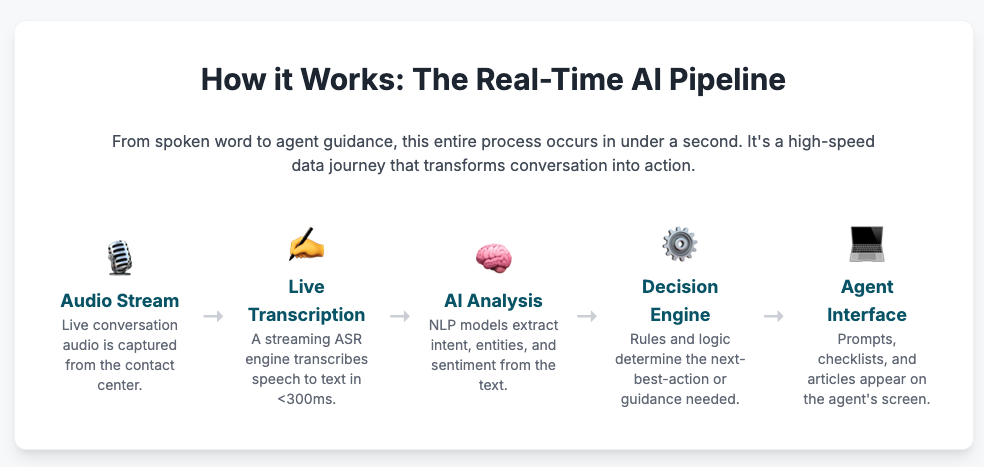What is real-time agent assist? How AI transforms live customer support
Real-Time Agent Assist (RTAA) uses AI to guide customer service agents during live calls with instant knowledge, compliance alerts, and next-best actions. Here's how it works and why it matters.



When a frustrated customer calls about a billing error, every second counts. Real-Time Agent Assist (RTAA) transforms these critical moments by giving agents AI-powered guidance exactly when they need it.
Contact centers struggling with these rising expectations find their agents face mounting pressure to deliver exceptional service while they navigate complex systems, adhere to compliance requirements, and manage increasingly sophisticated customer inquiries. This tension between rising expectations and operational complexity has created an urgent need for innovative solutions that empower agents without sacrificing the human touch customers value.
Real-Time Agent Assist (RTAA) is an AI-powered technology that changes how contact centers operate. RTAA provides intelligent, contextual guidance to agents during live conversations—it bridges the gap between human empathy and machine efficiency to create a new paradigm for customer service excellence.
What real-time agent assist actually does
Real-Time Agent Assist is an AI-driven system that listens to live customer conversations and provides agents with immediate, contextual support directly on their screens. Consider it an intelligent co-pilot that works alongside human agents; the system analyzes conversations as they unfold and surfaces relevant information, suggested responses, and compliance reminders—all within milliseconds.
Traditional contact center tools rely on static scripts or post-call analysis. RTAA operates differently—it uses accurate speech recognition to process speech in real-time to understand context, detect sentiment, and predict the best course of action. This dynamic assistance helps agents handle inquiries more efficiently while they maintain the personal connection that builds customer loyalty.
The technology represents a shift from reactive to proactive support. Rather than reviewing calls after the fact to identify what went wrong, RTAA intervenes during the conversation to make things go right the first time. This real-time intervention capability can mean the difference between a satisfied customer and a lost opportunity.
How it works: The real-time AI pipeline
The process that transforms spoken words into actionable intelligence requires a sophisticated AI pipeline. This process occurs in under a second and involves multiple interdependent stages working in perfect synchronization.

Audio stream: The journey begins when live conversation audio is captured from the contact center's telephony system. Both the customer's and agent's voices are streamed separately; this ensures clear distinction between speakers. This dual-channel approach provides the context-aware assistance agents need.
Live transcription: The audio immediately flows to a streaming Automatic Speech Recognition (ASR) engine—the most critical component of the entire system. This engine must convert speech to text with exceptional accuracy while it maintains ultra-low latency. Leading real-time ASR providers achieve transcription latency of approximately 300 milliseconds, fast enough to feel instantaneous to the agent. The quality of this real-time transcription determines the effectiveness of every subsequent step.
AI analysis: Once transcribed, the text undergoes sophisticated analysis through multiple AI models working in parallel:
- Natural Language Processing (NLP) extracts the customer's intent and key information like account numbers or product names
- Sentiment analysis evaluates emotional tone and flags frustration or satisfaction
- Compliance monitoring checks for required disclosures or prohibited language
Decision engine: The analyzed data feeds into a central decision engine that synthesizes all inputs to determine the most appropriate assistance. This might involve retrieving knowledge base articles, suggesting retention offers, or alerting supervisors to escalating situations. The engine operates on a combination of business rules and machine learning models that improve over time.
Agent interface: The guidance appears on the agent's screen through an intuitive interface designed to inform without distracting. Recommendations might appear as discrete cards, dynamic checklists, or subtle prompts integrated directly into the agent's workflow.
Key capabilities that transform customer interactions
Real-Time Agent Assist encompasses a suite of capabilities; each addresses specific challenges agents face during customer interactions. These features work together to create a comprehensive support system that enhances both efficiency and effectiveness.
Instant knowledge retrieval
Automated knowledge retrieval eliminates a major pain point for agents. Traditionally, agents waste valuable time searching through dense knowledge bases or placing customers on hold to consult supervisors. RTAA eliminates this friction—it understands questions in context and instantly surfaces the most relevant information.
Modern implementations leverage Retrieval-Augmented Generation (RAG) to go beyond simple document linking. The system retrieves specific passages from multiple sources and uses large language models to synthesize concise, contextual answers. Agents receive exactly what they need, when they need it, formatted for quick comprehension and immediate use.
Sentiment analysis
Maintaining awareness of customer emotions across dozens of daily interactions challenges even experienced agents. Real-time sentiment analysis acts as an emotional barometer; it continuously monitors both what customers say and how they say it.
The technology analyzes linguistic patterns, tone variations, and speech characteristics to detect customer sentiment like frustration, confusion, or satisfaction. This insight appears as visual indicators on the agent's screen—perhaps a color-coded sentiment meter or trend line showing emotional trajectory throughout the call. When sentiment drops below critical thresholds, the system can automatically alert supervisors, enabling timely intervention through whisper coaching or direct assistance.
The business impact of real-time agent assist
The value of RTAA shows up clearly in measurable business outcomes. Organizations implementing these systems report significant improvements across key performance indicators; benefits extend far beyond simple efficiency gains. Modern speech analytics capabilities transform contact center results across multiple dimensions.
Operational efficiency gains
Average Handle Time (AHT) sees dramatic reductions when agents no longer waste time searching for information or struggling with complex processes. Conservative estimates indicate AHT improvements of 20-25%, though some deployments achieve even greater gains. This efficiency translates directly to cost savings and increased capacity without additional headcount.
First Call Resolution (FCR) rates improve by 30% or more as agents access accurate information and receive guidance for complex issues. This improvement creates a virtuous cycle—customers experience faster resolution, leading to higher satisfaction, while the organization reduces costly repeat contacts and escalations.
Revenue and retention impact
RTAA drives tangible business results beyond operational metrics. Next-best-action recommendations help agents identify and act on revenue opportunities that might otherwise be missed. The technology helps agents suggest relevant add-on services or present retention offers to at-risk customers; this data-driven approach benefits both customer and company.
Agent retention itself becomes a powerful ROI driver. Organizations implementing comprehensive RTAA solutions report significant improvements in agent retention. This dramatic reduction in turnover eliminates substantial costs associated with recruiting, training, and ramping new agents while preserving institutional knowledge and customer relationships.
The compound effect of agent experience
RTAA transforms the agent experience in ways that multiply all other benefits. The technology reduces cognitive load and provides continuous support; this creates a less stressful, more rewarding work environment. Agents report feeling more confident and capable, leading to improved job satisfaction and performance.
This enhanced agent experience creates a compounding effect on all other metrics. Experienced, confident agents naturally provide better service, resolve issues more effectively, and identify opportunities more readily. The technology doesn't just make agents faster—it makes them better.
Implementation considerations: Building on the right foundation
Deploying Real-Time Agent Assist requires careful attention to technical requirements, integration challenges, and organizational readiness. Achieving the promised benefits demands a thoughtful implementation approach.
The critical role of speech recognition
The entire RTAA ecosystem depends on accurate, low-latency speech recognition. Even the most sophisticated AI analysis becomes worthless if the underlying transcription contains errors.
Contact center audio presents unique challenges for accurate transcription.
Contact centers deal with several audio quality issues:
- Background noise from both agent and customer environments
- Diverse accents, dialects, and speaking styles
- Technical jargon and company-specific terminology
- Compressed audio from traditional telephony systems
The ASR engine must handle these challenges while maintaining sub-300-millisecond latency—a technical feat that few providers achieve reliably. Organizations must carefully evaluate ASR capabilities; look for features like:
- Custom vocabulary support for industry-specific terms
- Robust noise handling and acoustic modeling
- Speaker diarization to distinguish between speakers
- Confidence scoring to indicate transcription reliability
Leading providers like AssemblyAI offer specialized models designed for contact center environments, including the new Universal-Streaming model with immutable transcripts that provide stable input for downstream processing—a critical requirement for maintaining low end-to-end latency. A robust streaming infrastructure forms the foundation for successful real-time agent assist deployment.
Integration and change management
Technical integration extends beyond the ASR layer. RTAA systems must connect seamlessly with existing contact center infrastructure, CRM systems, knowledge bases, and compliance tools. This integration complexity requires careful planning; organizations often use phased implementation approaches.
Organizational change management matters just as much as technical integration. Agents may initially view AI assistance with skepticism or concern about job security. Successful deployments emphasize that RTAA augments rather than replaces human agents—the technology empowers rather than automates. Comprehensive training programs and gradual rollouts help build confidence and adoption.
Security and compliance considerations
Real-time processing of customer conversations raises important security and privacy considerations. Organizations must verify their RTAA solution meets regulatory requirements for data handling, encryption, and retention. This becomes particularly critical in regulated industries like healthcare and financial services, where conversation data may contain sensitive personal information.
The future of agent assistance: Emerging trends
The RTAA landscape continues to evolve rapidly, driven by advances in artificial intelligence and changing customer expectations. Several key trends shape the technology's future trajectory.
Generative AI integration
The integration of generative AI marks a significant evolution—systems now create and synthesize rather than just retrieve and suggest. Modern RTAA platforms increasingly leverage large language models to generate complete response drafts, create instant call summaries, and even engage in dynamic knowledge base interactions. Agents can ask natural language questions and receive synthesized answers from multiple sources.
This generative capability extends to post-call automation; AI creates comprehensive interaction summaries, extracts action items, and updates CRM records without agent intervention. The time savings are substantial—after-call work often reduces by 50% or more.
The path to autonomous actions
The industry is moving toward "agentic AI"—systems capable of taking autonomous actions on behalf of human agents. Rather than simply suggesting that an agent process a refund, future systems might handle the entire refund workflow automatically. They'll navigate applications, fill forms, and execute transactions under agent supervision.
This evolution promises to further reduce the mechanical aspects of agent work. Humans can focus exclusively on relationship building, complex problem-solving, and situations requiring genuine empathy and creativity.
Conclusion
Real-Time Agent Assist transforms contact centers by solving their biggest challenge: delivering personalized support at scale. Success hinges on choosing the right speech recognition foundation—everything else depends on accurate, low-latency transcription. As RTAA evolves toward autonomous capabilities, early adopters gain competitive advantage through better customer experiences and happier agents. The question isn't whether to implement RTAA, but how fast you can deploy it effectively.
Lorem ipsum dolor sit amet, consectetur adipiscing elit, sed do eiusmod tempor incididunt ut labore et dolore magna aliqua. Ut enim ad minim veniam, quis nostrud exercitation ullamco laboris nisi ut aliquip ex ea commodo consequat. Duis aute irure dolor in reprehenderit in voluptate velit esse cillum dolore eu fugiat nulla pariatur.

%20audio%20with%20timestamps%20for%20captions%20with%20AssemblyAI.png)